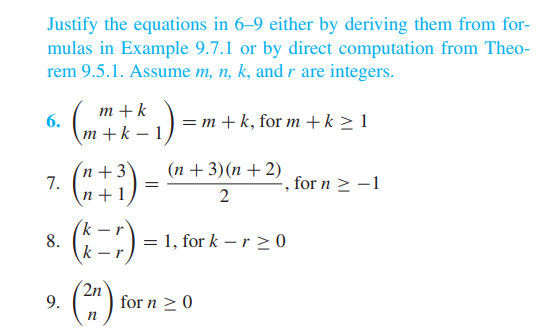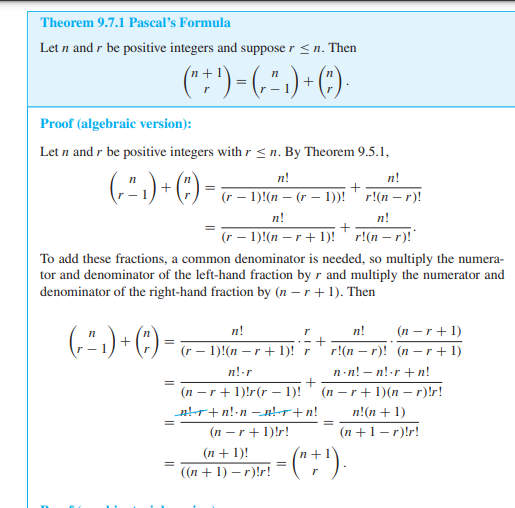7. (+1) (n+3 (n+3)(n+2) 2 for n ≥ -1
Linear Algebra: A Modern Introduction
4th Edition
ISBN:9781285463247
Author:David Poole
Publisher:David Poole
Chapter2: Systems Of Linear Equations
Section2.4: Applications
Problem 33EQ
Related questions
Question
Can you please help with #7 and #9? TIA

Transcribed Image Text:Justify the equations in 6-9 either by deriving them from for-
mulas in Example 9.7.1 or by direct computation from Theo-
rem 9.5.1. Assume m, n, k, and r are integers.
6. (m+k₁) -
= m + k, for m+k≥ 1
1
n+3
7. (+³)
=
(n+3)(n+2)
2
, for n ≥ -1
n+1
8.
(7) = 1, for k-r≥0
k
r
2n
9.
(²2)
for n ≥ 0
n

Transcribed Image Text:Theorem 9.7.1 Pascal's Formula
Let n and r be positive integers and suppose r ≤n. Then
n+
(" + ¹) = ( ² ) + ( ) ·
r
Proof (algebraic version):
Let n and r be positive integers with r ≤n. By Theorem 9.5.1,
n!
( ²₁ ) + ( )=
+
(r − 1)!(n − (r − 1))!
-
r!(n-r)!
n!
n!
+
(r − 1)!(n − r + 1)!r!(n-r)!*
To add these fractions, a common denominator is needed, so multiply the numera-
tor and denominator of the left-hand fraction by r and multiply the numerator and
denominator of the right-hand fraction by (n-r+1). Then
n!
r
n!
(²₁) + ( )
(r − 1)!(n −r + 1)! r
(n-r+1)
r!(n-r)! (nr+1)
n-n! -n!-r+n!
n!.r
(n-r+1)!r(r 1)!
(nr+1)(n-r)!r!
_n!+r+n!•n__n!r+n!
=
n!(n + 1)
(n+1-r)!r!
(n-r+1)!r!
(n + 1)!
=
((n + 1) -r)!r!
=
= ("+¹).
Expert Solution
This question has been solved!
Explore an expertly crafted, step-by-step solution for a thorough understanding of key concepts.
This is a popular solution!
Trending now
This is a popular solution!
Step by step
Solved in 2 steps with 2 images

Follow-up Questions
Read through expert solutions to related follow-up questions below.
Follow-up Question
Thank you. Can you please explain why you multiplied by 2! in the denominator in step 2? How does that 2! get there?
Solution
Recommended textbooks for you

Linear Algebra: A Modern Introduction
Algebra
ISBN:
9781285463247
Author:
David Poole
Publisher:
Cengage Learning

Elementary Geometry For College Students, 7e
Geometry
ISBN:
9781337614085
Author:
Alexander, Daniel C.; Koeberlein, Geralyn M.
Publisher:
Cengage,

Linear Algebra: A Modern Introduction
Algebra
ISBN:
9781285463247
Author:
David Poole
Publisher:
Cengage Learning

Elementary Geometry For College Students, 7e
Geometry
ISBN:
9781337614085
Author:
Alexander, Daniel C.; Koeberlein, Geralyn M.
Publisher:
Cengage,